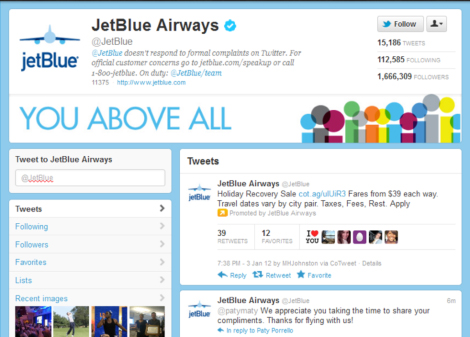Stewart Brand was once quoted as saying, “Once a new technology rolls over you, if you’re not part of the steamroller, you’re part of the road”.
If you’re not marketing savvy, then it’s quite likely you feel part of the road as new technology and tools roll right over you. And in 2012, it’s likely that the pace of development will pick up.
But as we know, January is the time for resolutions; so while you’re making your list of health and career goals, why not throw in a few social media resolutions as well? The bigger your organization, the more important it is to develop a social media policy that filters to all levels. Think in terms of customer service training – your staff needs to be trained to act proactively and react responsibly.
Getting organized is the first step to understanding and mastering social media.
1. Stake your claim: Your brand is your business, and before someone else jumps in with a similar moniker, it’s time to claim your name. Signing on to social networking sites is not only easy; it’s free as well. So decide on a unified brand name and create a profile on major (and minor) accounts. There are plenty of options when deciding on a name; celebrities like Guy Kawasaki prefer to use their own name. Some like Mashable use their business name. And others might decide to stick to their recognized brand name, like Pepsi does.
Not sure if your handle is taken? You can check if your preferred name is available on Know’em. You can also sign on to sites like Reputation.com, which help you control and monitor your online reputation. Alternatively, set up Google or Twitter alerts, which notify you when someone mentions your name.
2. Appoint a social media team: Social media can be a vast and complex playground, and unless you have the time and knowledge to work it, it’s best to develop a team of members to implement and measure your strategies. Create a core team of internal staff members involving all your departments, including customer service, web analytics, public relations, marketing, and legal.
3. Establish a participation policy: One of the first things to develop is an official employee policy for social media and web based publishing. This gives your entire organization a blueprint for how to operate in a social context and sets both expectations and limitations. Your policy could be integrated, which covers all social media and online channels. An example is the City of Hampton’s Social Media Policy, which is 5 pages outlining definitions, blog standards, and employee guidance for participating in social networking. Or it could be targeted to an individual medium, such as Feedster’s Corporate Blogging Policy, which outlines guidelines for its bloggers.
Whatever you decide on, you need to determine beforehand what kind of information is allowed. For example, you might consider restricting the sharing of proprietary information or negative comments on competitors. You might also determine that posts are approved before they go live.
4. Create a crisis management plan: Because social media is in real time, any mistake made can have tremendous implications for the brand. A well-recognized example is from Kenneth Cole. During the 2011 Cairo riots, they tweeted: Millions are in uproar in #Cairo. Rumor is they heard our new spring collection is now available online at http://bit.ly/KCairo -KC (this tweet has since been removed)
Insensitive to say the least. Their next tweet was this one:
While time and plenty of tweets have managed to wipe out this gaffe, not all companies might be so lucky. The implications are tremendous and a warning to companies that try to add levity to a serious situation or exploit a current potential explosive new story.
In these instances, a well-crafted social media crisis policy comes in handy. It should ideally consist of quick and appropriate responses that can be leveraged if you’ve created a political or social blunder, or if a disgruntled customer wants to have a go at you.
5. Communicate your participation and crisis policies to all staff: If you plan on fostering a more socially active environment, you need to communicate all policies to staff. Plan on developing a culture of listening and trust, by scheduling in training sessions and outlining transparency issues. Review policies and legal queries and ensure all disclosures are made available to customers. Clearly define who will handle what, so employees know what they can or cannot write, comment, or discuss.
6. Legalize who owns your blog or social media following: In a ruling in fall 2011 filed by PhoneDog.com against employee Noah Kravitz, the judge in question decided that the lawsuit claims are within reason. The company is suing Kravitz over trade secrets and misappropriation of the account and is claiming damages running to hundreds of thousands of dollars. Why? When Noah Kravitz left PhoneDog, he changed his twitter handle from @PhoneDog_Noah to @NoahKravitz and took the account with him.
Does your audience follow your brand or your spokesperson? When your spokesperson leaves, does he transfer ownership of his accounts back to the company? It’s important to clarify that the brand, not the employee owns the account and to guard against any name changes.
7. Share updates on communication and best practices: Not sure how to share information internally? There are plenty of tools which allow employee communications and encourage shared information. My favorite is Yammer, a microblogging B2B communication tool that lets employees discuss topics and share internal policies. Other tools to explore include Digsby, Skype, and Sharepoint.
8. Monitor your accounts regularly: Daily monitoring is important, especially if multiple employees are posting across networks. Some companies like JetBlue help out their employees by letting their audiences know they have a special hotline for complaints and issues and will not address them on their social media websites. This is one way to reduce online risk that might otherwise arise if an employee has to deal with a disgruntled customer.
And so how do implementing social media policies really help you?
Your biggest assets are your employees. If you make them a part of your social media team, you create a virtual network of loyalists to promote brand and image at the fraction of what it would take to pay a marketing agency to do the same job. So if you’ve been hesitant to use your staff as a marketing force, drop your blanket ‘no social media’ policy and instead use the above ideas to figure out what works best to make you and your company socially ready.











